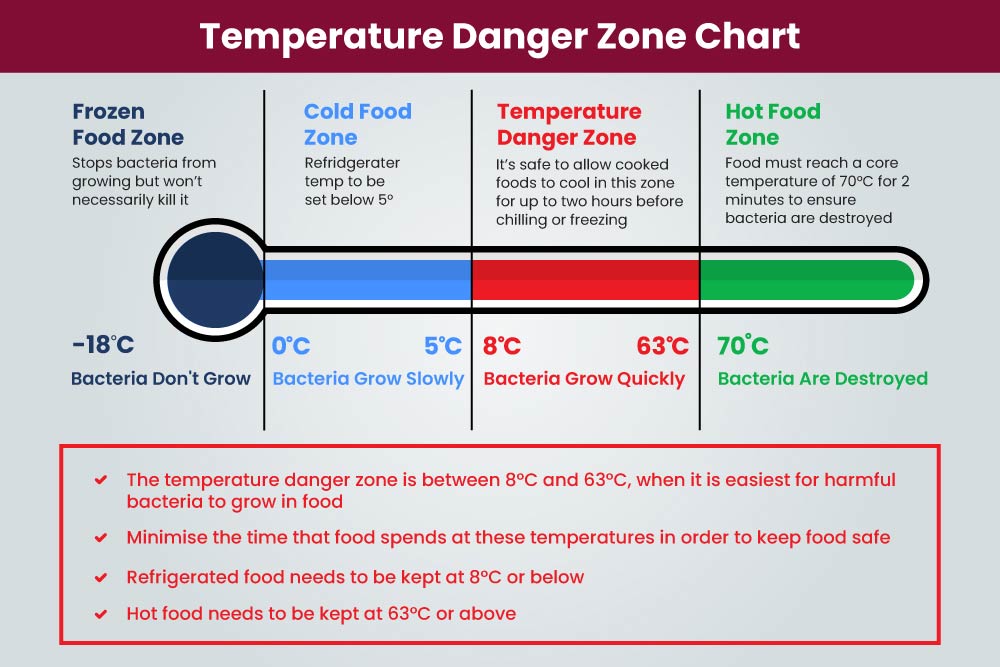
Courtesy: Human Focus
Proper food storage is equally critical in preventing foodborne illnesses, with the “danger zone” between 40 degrees Fahrenheit and 140 degrees Fahrenheit, representing conditions where bacteria multiply rapidly. Refrigerators should be maintained below 40 degrees Fahrenheit and regularly cleaned to prevent cross-contamination. Freezers should stay at or below zero for optimal food preservation.
The hot:
Buying larger portions or family sized items may be more economical, but how do you translate that if you are cooking for one-to-two people? You can cook the entire item and store the leftovers, but there are tips and tricks to prepare food safely.
Experts agree that the safest way to refrigerate hot food is to divide it into smaller portions that will cool down fast. To do this, you might carve whole roasts like turkey or ham and divide soups and casseroles into shallow containers no more than two inches deep. If possible, cover them only loosely at first to let steam escape before sealing tight.
The cold:
The faster food freezes, the smaller and less disruptive its ice crystals will be, helping it keep more of its structure as it thaws, according to the United States Department of Agriculture. Meat and seafood will stay juicier, fruits and vegetables more intact, creamy, cheesy emulsions less prone to splitting.
So quickly ice down any food heading to the freezer or give it a stint in the fridge first. And when freezing liquids, be sure to leave space at the top so they can expand–not explode–as they freeze.
Food Safety and Food Recalls due to Contamination
Food contamination remains one of the most significant challenges in the global food supply chain, affecting millions of consumers annually. When pathogens such as E. coli, Salmonella, or Listeria are detected in food products, manufacturers and regulatory agencies must act swiftly to protect public health through recalls.
These recalls, which have increased in frequency over the past decade due to improved detection methods, serve as critical safety measures to prevent widespread illness and potential fatalities.
The economic impact of food recalls extends far beyond the immediate cost of pulling products from shelves. Companies facing recalls often experience devastating financial losses, with some smaller businesses unable to recover from the combination of direct costs, legal liabilities, and long-term brand damage. For larger corporations, a major recall can result in losses measuring in the hundreds of millions of dollars, highlighting the economic incentive for maintaining rigorous safety protocols throughout production.
Regulatory frameworks vary significantly across countries, though most developed nations have established comprehensive systems for monitoring and responding to food safety threats.
In the United States, the Food and Drug Administration and the USDA oversee most food recalls, classifying them into three levels of severity based on the potential health risk.
Class I recalls, the most serious, involve situations where exposure to the contaminated product carries a reasonable probability of serious health consequences or death.
Prevention remains the most effective strategy in maintaining food safety, with modern approaches incorporating multiple hurdles throughout the production chain. These include implementing the Hazard Analysis Critical Control Points systems, conducting regular microbiological testing, maintaining strict temperature controls, and ensuring proper employee training and hygiene practices.
Advanced technologies such as blockchain are increasingly being deployed to enhance traceability, allowing contamination sources to be identified and addressed more rapidly.
Institutional food supplies are no less susceptible to issues than grocery stores and public restaurants. Awareness is key for those that provide meals in institutions just as those who work in food service to the public.
Consumer education plays a crucial role in the food safety ecosystem, as proper handling and preparation can significantly reduce the risk of foodborne illness even when contamination occurs. Understanding safe cooking temperatures, avoiding cross-contamination between raw and cooked foods, and remaining informed about current recalls through resources like the FDA’s Recalls, Market Withdrawals, and Safety Alerts database empowers individuals to protect themselves and their families.
When combined with robust industry practices and effective regulatory oversight, these consumer efforts help create a comprehensive approach to minimizing the impact of food contamination.
The list below provides information gathered from press releases and other public notices about certain recalls of FDA-regulated products. Not all recalls have press releases or are posted on this page. See additional information about recalls for a more complete listing.